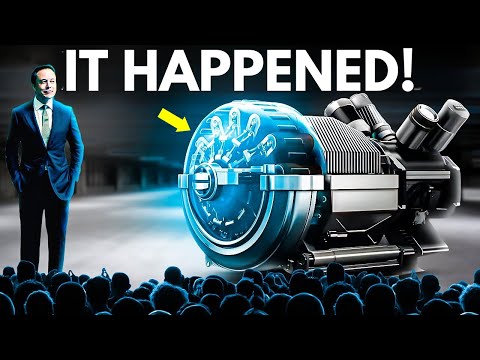Elon Musk SHOCKS EV Industry By REVEALING Tesla NEW Engine!
Tesla’s New EV Motor: Is This the Powertrain That Will Shock the Industry?
When Elon Musk hints at something "unbelievable," the auto world braces itself—and Tesla's latest buzz about a revolutionary new electric motor is no exception. Whether it's destined for the upcoming Cybercab or the next Model S Plaid, this motor could be Tesla’s biggest hardware leap since its switch to the 4680 battery cell.
We’re talking about a motor that might ditch rare earths entirely, wrap its rotor in carbon fiber, and use ultra-precise hairpin windings for boosted efficiency. It's lighter, cheaper, more durable, and possibly near impossible for rivals to replicate thanks to Tesla’s vertical manufacturing approach. If they can scale it—and that’s a big “if”—it might leave competitors like BYD and Volkswagen playing catch-up once again.
Hairpin Windings and Ferrite Magnets: Small Pieces, Big Performance
Tesla has already proven what hairpin winding tech can do—better copper utilization, lower heat, and more torque at the wheels. Now imagine that combined with ferrite-based magnets instead of rare earths like neodymium. They’re cheaper, easier to source, and better aligned with Tesla’s sustainability narrative.
That shift could drastically cut costs. Tesla might even bring a $25,000–$30,000 EV to market with it. Plus, ferrite motors sidestep geopolitical bottlenecks, reducing dependence on rare earth exports from China. For a company that likes to control its destiny, that’s a strategic win.
Carbon-Wrapped Rotor: Lightweight Strength for High-Speed EVs
The rumored carbon-wrapped rotor? That’s the kind of material science usually reserved for aerospace labs. Wrapping the rotor in carbon allows higher RPMs without distortion or failure. For the next-gen Tesla Roadster or performance-focused Cybertruck, that translates to sub-2-second 0–60 launches and less drivetrain stress at high speed.
It also means a lighter motor, which—paired with Tesla’s new “unboxed” vehicle assembly process—could open the door to radically more efficient EVs. Lighter cars need less battery, which brings even more cost savings and better range with the same energy draw.
Sustainability Without Sacrifice: No Rare Earths, No Problem
Rare earths have long been a headache for EV makers—expensive, geopolitically fraught, and environmentally messy to mine. Tesla’s shift toward ferrite magnets could mean the end of that dependency. It's a bold move that reinforces the brand's green credibility, especially as governments in the EU and U.S. push for cleaner tech supply chains.
This move isn’t just optics. By eliminating rare earths and improving thermal management, Tesla might reduce material waste, simplify recycling, and align even closer with its zero-emission mission. As sustainability gains weight in consumer decisions, that could matter more than horsepower numbers.
Lower Costs, Higher Reach: The $25K EV May Finally Be Real
If this motor delivers on efficiency and cost reduction, Tesla could finally unlock its long-promised low-cost EV. Think $25,000 to $30,000—competitive with combustion cars and a direct threat to low-end models from BYD, Nissan, and even Toyota. The real magic here? It could come without sacrificing the signature Tesla acceleration and tech package.
Musk has hinted that new factories—like the one planned in Mexico—will be the proving grounds for this motor-tech + low-cost combo. With the help of the “unboxed” assembly strategy and new modular vehicle platforms, Tesla could ship millions of these next-gen vehicles globally by 2027.
Robotaxi Ready: Motor Durability for Autonomous EVs
Durability matters more than ever when you’re building a vehicle designed to run 24/7. Tesla’s robotaxi dreams rest on hardware that doesn’t flinch at a million miles of abuse. The new motor, with its carbon-wrapped rotor and improved thermal efficiency, might be the key enabler for the Cybercab fleet slated for production in 2026.
It’s not just about speed anymore—it’s about smart, efficient performance that can last. If Tesla nails the hardware, it could roll out self-driving vehicles that are more profitable, longer-lasting, and easier to scale than anything the competition’s working on.
Market Disruption and Competitive Impact: Can Rivals Keep Up?
The EV space is already cutthroat, and Tesla’s new motor tech could widen the gap. Legacy automakers like VW and Ford are still catching up to Tesla’s software edge, let alone drivetrain advancements. Even BYD—Tesla’s fiercest Chinese competitor—is pushing fast-charging and battery innovation, but not yet matching Tesla in integrated motor design.
Ferrite motors with advanced windings and carbon structures won’t be easy to clone. Tesla’s ability to build everything in-house—from AI chips to wiring looms—gives it a moat that few can cross. If they choose to open-source parts of the design like they have with patents in the past, expect a ripple effect across the entire industry.
The Reality Check: Risks and Roadblocks
No Tesla innovation story is complete without a few caveats. Remember Full Self-Driving timelines? Or the 4680 battery delays? New manufacturing processes are notoriously tricky to scale, and if this motor tech requires novel machinery or materials, rollouts could hit speed bumps.
There’s also the elephant in the showroom: Elon Musk himself. A 13% dip in Q1 2025 sales shows the market’s sensitivity to his behavior and political associations. Even groundbreaking tech may struggle for attention if consumers are turned off by the brand’s public persona.








